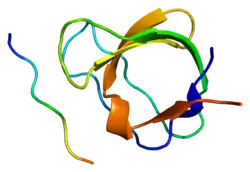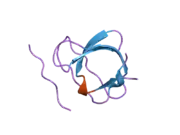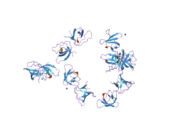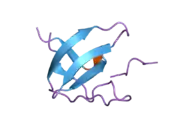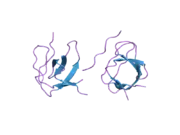CD2AP
CD2-associated protein is a protein that in humans is encoded by the CD2AP gene.[5][6]
Function
This gene encodes a scaffolding molecule that regulates the actin cytoskeleton. The protein directly interacts with filamentous actin and a variety of cell membrane proteins through multiple actin binding sites, SH3 domains, and a proline-rich region containing binding sites for SH3 domains. The cytoplasmic protein localizes to membrane ruffles, lipid rafts, and the leading edges of cells. It is implicated in dynamic actin remodeling and membrane trafficking that occurs during receptor endocytosis and cytokinesis. Haploinsufficiency of this gene is implicated in susceptibility to glomerular disease.[6]
Interactions
CD2AP has been shown to interact with:
See also
References
- GRCh38: Ensembl release 89: ENSG00000198087 - Ensembl, May 2017
- GRCm38: Ensembl release 89: ENSMUSG00000061665 - Ensembl, May 2017
- "Human PubMed Reference:". National Center for Biotechnology Information, U.S. National Library of Medicine.
- "Mouse PubMed Reference:". National Center for Biotechnology Information, U.S. National Library of Medicine.
- Kirsch KH, Georgescu MM, Ishimaru S, Hanafusa H (Jun 1999). "CMS: An adapter molecule involved in cytoskeletal rearrangements". Proc Natl Acad Sci USA. 96 (11): 6211–6. doi:10.1073/pnas.96.11.6211. PMC 26861. PMID 10339567.
- "Entrez Gene: CD2AP CD2-associated protein".
- Haglund K, Ivankovic-Dikic I, Shimokawa N, Kruh GD, Dikic I (May 2004). "Recruitment of Pyk2 and Cbl to lipid rafts mediates signals important for actin reorganization in growing neurites". J. Cell Sci. 117 (Pt 12): 2557–68. doi:10.1242/jcs.01148. PMID 15128873.
- Kirsch KH, Georgescu MM, Shishido T, Langdon WY, Birge RB, Hanafusa H (Feb 2001). "The adapter type protein CMS/CD2AP binds to the proto-oncogenic protein c-Cbl through a tyrosine phosphorylation-regulated Src homology 3 domain interaction". J. Biol. Chem. 276 (7): 4957–63. doi:10.1074/jbc.M005784200. PMID 11067845.
- Cormont M, Metón I, Mari M, Monzo P, Keslair F, Gaskin C, McGraw TE, Le Marchand-Brustel Y (Feb 2003). "CD2AP/CMS regulates endosome morphology and traffic to the degradative pathway through its interaction with Rab4 and c-Cbl". Traffic. 4 (2): 97–112. doi:10.1034/j.1600-0854.2003.40205.x. PMID 12559036. S2CID 38612642.
- Schwarz K, Simons M, Reiser J, Saleem MA, Faul C, Kriz W, Shaw AS, Holzman LB, Mundel P (Dec 2001). "Podocin, a raft-associated component of the glomerular slit diaphragm, interacts with CD2AP and nephrin". J. Clin. Invest. 108 (11): 1621–9. doi:10.1172/JCI12849. PMC 200981. PMID 11733557.
- Lehtonen S, Lehtonen E, Kudlicka K, Holthöfer H, Farquhar MG (Sep 2004). "Nephrin forms a complex with adherens junction proteins and CASK in podocytes and in Madin-Darby canine kidney cells expressing nephrin". Am. J. Pathol. 165 (3): 923–36. doi:10.1016/S0002-9440(10)63354-8. PMC 1618613. PMID 15331416.
Further reading
- Bonaldo MF, Lennon G, Soares MB (1997). "Normalization and subtraction: two approaches to facilitate gene discovery". Genome Res. 6 (9): 791–806. doi:10.1101/gr.6.9.791. PMID 8889548.
- Dustin ML, Olszowy MW, Holdorf AD, Li J, Bromley S, Desai N, Widder P, Rosenberger F, van der Merwe PA, Allen PM, Shaw AS (1998). "A novel adaptor protein orchestrates receptor patterning and cytoskeletal polarity in T-cell contacts". Cell. 94 (5): 667–77. doi:10.1016/S0092-8674(00)81608-6. PMID 9741631. S2CID 18042803.
- Lehtonen S, Ora A, Olkkonen VM, Geng L, Zerial M, Somlo S, Lehtonen E (2000). "In vivo interaction of the adapter protein CD2-associated protein with the type 2 polycystic kidney disease protein, polycystin-2". J. Biol. Chem. 275 (42): 32888–93. doi:10.1074/jbc.M006624200. PMID 10913159.
- Li C, Ruotsalainen V, Tryggvason K, Shaw AS, Miner JH (2000). "CD2AP is expressed with nephrin in developing podocytes and is found widely in mature kidney and elsewhere". Am. J. Physiol. Renal Physiol. 279 (4): F785–92. doi:10.1152/ajprenal.2000.279.4.F785. PMID 10997929.
- Kirsch KH, Georgescu MM, Shishido T, Langdon WY, Birge RB, Hanafusa H (2001). "The adapter type protein CMS/CD2AP binds to the proto-oncogenic protein c-Cbl through a tyrosine phosphorylation-regulated Src homology 3 domain interaction". J. Biol. Chem. 276 (7): 4957–63. doi:10.1074/jbc.M005784200. PMID 11067845.
- Schwarz K, Simons M, Reiser J, Saleem MA, Faul C, Kriz W, Shaw AS, Holzman LB, Mundel P (2002). "Podocin, a raft-associated component of the glomerular slit diaphragm, interacts with CD2AP and nephrin". J. Clin. Invest. 108 (11): 1621–9. doi:10.1172/JCI12849. PMC 200981. PMID 11733557.
- Scott MP, Zappacosta F, Kim EY, Annan RS, Miller WT (2002). "Identification of novel SH3 domain ligands for the Src family kinase Hck. Wiskott-Aldrich syndrome protein (WASP), WASP-interacting protein (WIP), and ELMO1". J. Biol. Chem. 277 (31): 28238–46. doi:10.1074/jbc.M202783200. PMID 12029088.
- Badour K, Zhang J, Shi F, McGavin MK, Rampersad V, Hardy LA, Field D, Siminovitch KA (2003). "The Wiskott-Aldrich syndrome protein acts downstream of CD2 and the CD2AP and PSTPIP1 adaptors to promote formation of the immunological synapse". Immunity. 18 (1): 141–54. doi:10.1016/S1074-7613(02)00516-2. PMID 12530983.
- Cormont M, Metón I, Mari M, Monzo P, Keslair F, Gaskin C, McGraw TE, Le Marchand-Brustel Y (2003). "CD2AP/CMS regulates endosome morphology and traffic to the degradative pathway through its interaction with Rab4 and c-Cbl". Traffic. 4 (2): 97–112. doi:10.1034/j.1600-0854.2003.40205.x. PMID 12559036. S2CID 38612642.
- Lynch DK, Winata SC, Lyons RJ, Hughes WE, Lehrbach GM, Wasinger V, Corthals G, Cordwell S, Daly RJ (2003). "A Cortactin-CD2-associated protein (CD2AP) complex provides a novel link between epidermal growth factor receptor endocytosis and the actin cytoskeleton". J. Biol. Chem. 278 (24): 21805–13. doi:10.1074/jbc.M211407200. PMID 12672817.
- Hutchings NJ, Clarkson N, Chalkley R, Barclay AN, Brown MH (2003). "Linking the T cell surface protein CD2 to the actin-capping protein CAPZ via CMS and CIN85". J. Biol. Chem. 278 (25): 22396–403. doi:10.1074/jbc.M302540200. PMID 12690097.
- Kim JM, Wu H, Green G, Winkler CA, Kopp JB, Miner JH, Unanue ER, Shaw AS (2003). "CD2-associated protein haploinsufficiency is linked to glomerular disease susceptibility". Science. 300 (5623): 1298–300. doi:10.1126/science.1081068. PMID 12764198. S2CID 7106967.
- Schulze WX, Mann M (2004). "A novel proteomic screen for peptide-protein interactions". J. Biol. Chem. 279 (11): 10756–64. doi:10.1074/jbc.M309909200. PMID 14679214.
- Haglund K, Ivankovic-Dikic I, Shimokawa N, Kruh GD, Dikic I (2004). "Recruitment of Pyk2 and Cbl to lipid rafts mediates signals important for actin reorganization in growing neurites". J. Cell Sci. 117 (Pt 12): 2557–68. doi:10.1242/jcs.01148. PMID 15128873.
- Lehtonen S, Lehtonen E, Kudlicka K, Holthöfer H, Farquhar MG (2004). "Nephrin Forms a Complex with Adherens Junction Proteins and CASK in Podocytes and in Madin-Darby Canine Kidney Cells Expressing Nephrin". Am. J. Pathol. 165 (3): 923–36. doi:10.1016/S0002-9440(10)63354-8. PMC 1618613. PMID 15331416.
- Rush J, Moritz A, Lee KA, Guo A, Goss VL, Spek EJ, Zhang H, Zha XM, Polakiewicz RD, Comb MJ (2005). "Immunoaffinity profiling of tyrosine phosphorylation in cancer cells". Nat. Biotechnol. 23 (1): 94–101. doi:10.1038/nbt1046. PMID 15592455. S2CID 7200157.
- Coward RJ, Foster RR, Patton D, Ni L, Lennon R, Bates DO, Harper SJ, Mathieson PW, Saleem MA (2005). "Nephrotic plasma alters slit diaphragm-dependent signaling and translocates nephrin, Podocin, and CD2 associated protein in cultured human podocytes". J. Am. Soc. Nephrol. 16 (3): 629–37. doi:10.1681/ASN.2004030172. PMID 15659563.
This article is issued from Wikipedia. The text is licensed under Creative Commons - Attribution - Sharealike. Additional terms may apply for the media files.
